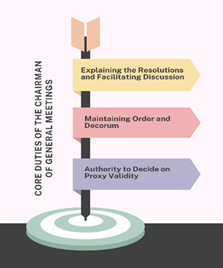In the sphere of corporate governance, general meetings are a vital forum through which shareholders exercise control and influence over the affairs of a company. Presiding over these meetings is a role of great significance — one that requires impartiality, order, and a sound understanding of both legal and procedural obligations. The Companies Act, 2013, along with Secretarial Standards (SS-2), provides a comprehensive framework for the appointment and responsibilities of the Chairman of general meetings. This blog explores the provisions surrounding the Chairman’s role and explains the process and duties that accompany it.
The legal backbone of the Chairman’s role in general meetings is provided under Section 104 of the Companies Act, 2013. This section outlines how a Chairman is appointed and the circumstances under which their role comes into play. Importantly, the Act recognizes the Articles of Association (AoA) of a company as the primary source of guidance for such appointments. If the AoA explicitly states who will preside over general meetings—typically the Chairman of the Board—then that provision is followed.
However, in the absence of such a clause, the members present at the meeting are vested with the power to elect one among themselves to act as Chairman. This election usually occurs through a show of hands unless a poll is demanded by the members, in which case the process becomes more formal and must comply with the requirements laid down under Section 109. In such a scenario, the meeting is adjourned and reconvened after the poll is completed, and the elected individual then assumes the chairmanship.
Appointment of the Chairman: Who Takes the Chair?
The default position under the Companies Act, 2013, is that the Chairman of the Board of Directors shall also act as the Chairman of the General Meeting. This is rooted in the logic that the individual entrusted with steering the company at the Board level is best suited to conduct shareholder meetings, given their awareness of the company’s affairs.
However, circumstances may arise where the Chairman of the Board is absent, unwilling to preside, or if no Chairman has been designated. In such situations, the responsibility shifts to the directors present at the meeting. They are then required to elect one among themselves to act as the Chairman. If only one director is present and expresses willingness, they may assume the role with the consent of the shareholders. In cases where no director is present or willing to preside, the members present at the meeting are empowered to elect one of themselves to act as the Chairman. This election is typically carried out through a show of hands, ensuring a democratic and transparent process.
Articles of Association and Custom Procedures
The Articles of Association (AoA) play a crucial role in determining the procedure for appointing the Chairman of a general meeting. If the Articles contain specific provisions in this regard, such as identifying a designated person or outlining a method of selection, those provisions must be strictly followed. This is particularly relevant for private companies, which enjoy greater flexibility under the Ministry of Corporate Affairs’ Notification dated June 5, 2015 (G.S.R. 464(E)). The notification allows private companies to deviate from the general rules, provided the Articles contain express provisions to that effect.
In such cases, the election of the Chairman must align with the internal governance framework adopted by the company through its Articles, overriding the default procedural hierarchy.
What Happens if a Poll is Demanded?
During the meeting, it is possible that members may demand a poll on the election of the Chairman. If this occurs, the poll must be conducted immediately in accordance with the Companies Act. Until the poll results are announced, the person elected by a show of hands continues to act as the Chairman and presides over the meeting. Once the poll concludes, the individual who receives the majority support becomes the Chairman for the remainder of the meeting, replacing the interim Chairman if necessary.
This mechanism reinforces the democratic nature of company meetings and ensures that the person conducting the meeting enjoys the confidence of the majority of shareholders.
Chairing an Adjourned Meeting
An adjourned meeting is considered a continuation of the original meeting, and therefore, as a general rule, the same Chairman should preside over it. However, if the original Chairman is absent, unwilling, or otherwise unable to continue, a new Chairman must be appointed following the same process as applicable to the original meeting. Interestingly, if the Chairman of the Board was absent at the original meeting but is present during the adjourned meeting, they are entitled to take the chair.
This continuity ensures consistency in handling the agenda and maintaining the procedural integrity of the meeting, even when spread across different sessions.

Core Duties and Responsibilities of the Chairman
The responsibilities of the Chairman extend far beyond calling the meeting to order. One of their primary duties is to ensure that the meeting is legally and properly constituted. This involves verifying the quorum, confirming the validity of proxies, and ensuring compliance with the Articles and other applicable legal requirements.
Once the procedural foundations are laid, the Chairman is expected to conduct the meeting in an orderly and fair manner. They must ensure that the discussion remains focused on the agenda items and that the business transacted aligns with what has been set out in the notice of the meeting. In doing so, the Chairman plays a pivotal role in safeguarding the legal sanctity of corporate decision-making.
Explaining the Resolutions and Facilitating Discussion
An essential function of the Chairman is to explain the resolutions, particularly those classified as special business. While explanatory statements accompany such items in the notice, it is imperative that the Chairman articulates the objectives and implications of each resolution in simple and clear language. This allows shareholders to make informed decisions, even if they do not possess technical or legal expertise.
The Chairman may, as needed, seek support from the Company Secretary, other Directors, or officers of the company to provide additional context or clarity. If material developments have taken place after the circulation of the meeting notice, these should also be communicated to the members, especially where they could influence voting outcomes.
Importantly, shareholders must be given a fair opportunity to ask questions, seek clarifications, and offer comments on the matters discussed. The Chairman must facilitate this dialogue in a balanced manner, ensuring that diverse viewpoints are heard and addressed, even when the majority may already appear to be aligned on a particular agenda item.
Maintaining Order and Decorum
One of the more delicate responsibilities of the Chairman is to maintain order and discipline during the proceedings. While debate and discussion are welcome, repetitive questions or irrelevant remarks can impede the progress of the meeting. In such cases, the Chairman has the discretion to restrict debate to ensure efficiency, without compromising fairness.
To manage time effectively, companies may invite shareholders to submit questions in advance. The Chairman can then group common queries and address them collectively during the meeting, ensuring clarity while also saving time.
Authority to Decide on Proxy Validity
The Chairman also enjoys the authority to determine the validity of proxies submitted by shareholders. This responsibility is not vested in scrutinisers or other officers. Judicial precedent has reinforced this authority — notably in Dawson v. Hormasji — confirming that the Chairman’s decision on the matter stands unless proven otherwise.
The ability to scrutinise and validate proxies is essential in ensuring that the voting rights are exercised only by those legitimately entitled to do so, thereby preserving the integrity of the voting process.
Chairman of General Meetings vs. Chairman of Board Meetings
While the titles may seem interchangeable, the roles of the Chairman of a general meeting and the Chairman of a Board meeting are distinctly different in their scope, authority, and the audience they serve.
The Chairman of a general meeting presides over AGMs and EGMs, which involve the shareholders of the company. Their responsibility is to ensure that the proceedings of these meetings comply with the provisions of the Companies Act, 2013, and the Articles of Association, and that the shareholders’ voices are heard in a fair and transparent manner. Their role is primarily regulatory and procedural, with an emphasis on neutrality and due process.
On the other hand, the Chairman of a Board meeting oversees meetings involving only the company’s directors. These meetings are focused on internal strategic decision-making, corporate planning, risk management, and operational oversight. The Chairman in this context often holds a leadership role within the company, such as the Managing Director or Executive Chairman, and may play an active part in shaping corporate policies. While they are expected to conduct meetings efficiently and fairly, the legal rigour and shareholder-facing duties that define general meetings do not apply in the same way.
Notably, in many companies, the same individual may serve as Chairman in both contexts. However, when presiding over a general meeting, even a Board Chairman must act within the limits of shareholder-centric statutory provisions, and not as a representative of the Board.
Conclusion
The role of the Chairman in a general meeting is both foundational and functional. It is not limited to procedural oversight, but extends to being the guardian of shareholder democracy and the facilitator of informed decision-making. From presiding over elections and explaining resolutions to managing disputes and preserving decorum, the Chairman stands at the helm of the company’s most important deliberative forum.
A Chairman who discharges their duties with integrity, neutrality, and competence not only ensures compliance with legal mandates but also reinforces the credibility of the company’s governance processes. As such, the Chairman is more than a figurehead — they are the custodian of order, fairness, and corporate accountability.
About the Author

My name is CA Bhunesh Kumar Goyal, I am a Practicing Chartered Accountant providing services of Income Tax Advisory, Tax Litigations, Accounting, Assurance, ESG Compliance, Corporate Advisory, Startup Advisory, GST Advisory, and Company Compliances apart from others.
